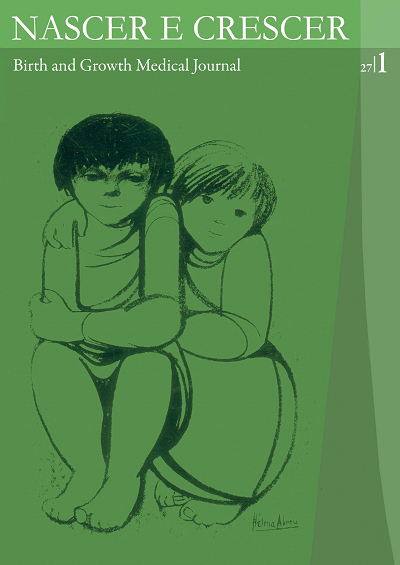Kawasaki disease and cardiovascular complications in pediatrics
DOI:
https://doi.org/10.25753/BirthGrowthMJ.v27.i1.10192Keywords:
Coronary aneurysms, Kawasaki disease, vasculitisAbstract
Introduction: Kawasaki disease (KD) is a systemic vasculitis of unknown etiology, which is the main cause of acquired heart disease in children in developed countries. It´s rare before six months of age and the main complications result from the development of coronary ectasia or aneurysms which can lead to ischemic heart disease.
Case report: We present a two-months-old child with diagnosis of incomplete KD, at the day eighth of fever, refractory to treatment with the first dose of immunoglobulin and aspirin. Echocardiographic evaluation performed in the acute phase showed diffuse ectasia of coronary arteries and perivascular brightness, with no other changes. He was treated with second dose of imunoglubulin and acetylsalicylic acid, with clinical improvement.
Conclusion: This clinical case report highlights the importance of early diagnosis and treatment of KD, as well as subsequent follow-up, bearing in mind the potential late cardiovascular complications of this pediatric disease.
Downloads
References
Newburger JW, Takahashi M, Gerber MA, Gewitz MH, Tani LY, Burns JC, et al. Diagnosis, treatment, and longterm management of Kawasaki Disease: a statement for health professionals from the committee on rheumatic fever, endocarditis, and kawasaki disease, council on cardiovascular disease in the young, american heart association. Pediatrics 2004; 114:1708-118.
Council on Cardiovascular Disease in the Young, Committee on Rheumatic Fever, Endocarditis and Kawasaki Disease, American Heart Association. Diagnostic guidelines for kawasaki disease. Circulation 2001; 103:335-6.
Burns JC, Kushner HI, Bastian JF, Shike H, Shimizu C, Matsubara T, et al. Kawasaki Disease: A brief history. Pediatrics 2000; 106: 1-8.
Nakamura Y, Yashiro M, Uehara R, Oki I, Watanabe M, Yanagawa H. Epidemiologic features of Kawasaki Disease: Results of the nationwide epidemiologic survey of Kawasaki disease in 2005-06. J Epidemiol 2008; 18: 167-72.
Lang B. Recognizing Kawasaki Disease. Paediatr Child Health 2001; 6: 638-43.
Heuclin T, Dubos F, Hue V, Godart F, Francart C, Vincent P. Increased detection rate of Kawasaki disease using new diagnostic algorithm, including early use of echocardiography. The J Pediatr 2009; 155:695-9.
Gouveia C, Brito M, Ferreira G, Ferreira M, Sampaio MA, Machado MC. Doença de Kawasaki – Casuística do Hospital Fernando da Fonseca. Rev Port Cardiol 2005; 24:1097-113.
Pereira A, Silva A, Álvares S. Síndrome de Kawasaki: Experiência da consulta de cardiologia pediátrica do Hospital Maria Pia. Nascer e Crescer 2000; 9:96-100.
Pinto, FF, Laranjo, S, Mota Carmo, M, Brito, MJ, Cruz Ferreira, R. Twelve Years of Kawasaki Disease in Portugal: Epidemiology in Hospitalized Children. Pediatric Infectious Disease Journal. 2017; 36:364–8.
Fimbres A, Shulman S. Kawasaki Disease. Pediatrics in Review. 2008; 29:308-16.
Tacke C, Burgner D, Kuipers I, Kuijpers TW. Management of acute and refractory Kawasaki disease. Expert Rev Anti Infect Ther. 2012; 10: 1203-15.
Santos V, Simões A, Teixeira A, Abecasis M, Loureiro M, Anjos R. Cirurgia de Revascularização coronária após Doença de Kawasaki. Rev Port Cardiol. 2012; 31:433-7
Kim J. A Case of Kawasaki Disease with Coronary Aneurysm Responding to the 4th IVIG Treatment. Case Rep Cardiol. 2014: 821812.
Chubb H, Simpson JM. The use of Z-scores in paediatric cardiology. Annals of Pediatric Cardiology. 2012; 5:179-84.
McCrindle BW, Li JS, Minich L, Colan SD, Atz AM, Takahashi M et al. Coronary Artery Involvement in Children With Kawasaki Disease – Risk Factors From Analysis of Serial Normalized Measurements. 2007; 116:174-9.
Tsuda E, Kamiya T, Ono Y, Kimura K, Kurosaki K, Echigo S. Incidence of stenotic lesions predicted by acute phase changes in coronary arterial diameter during Kawasaki disease. Pediatr Cardiol. 2005; 26:73–9
Saguil A, Fargo M, Grogan S. Diagnosis and Management of Kawasaky Disease. American Family Physician 2015. 91:6.
Saneeymehri S, Baker K, So T. Overview of Pharmacological Treatment Options for Pediatric Patients with Refractory Kawasaki Disease. J Pediatr Pharmacol Ther 2015. 20:3.
Downloads
Published
How to Cite
Issue
Section
License
Copyright and Authors' Rights
All articles published in Nascer e Crescer - Birth and Growth Medical Journal are Open Access and comply with the requirements of funding agencies or academic institutions. For use by third parties, Nascer e Crescer - Birth and Growth Medical Journal adheres to the terms of the Creative Commons License "Attribution - Non-Commercial Use (CC-BY-NC)".
It is the author's responsibility to obtain permission to reproduce figures, tables, etc. from other publications.
Authors must submit a Conflict of Interest statement and an Authorship Form with the submission of the article. An e-mail will be sent to the corresponding author confirming receipt of the manuscript.
Authors are permitted to make their articles available in repositories at their home institutions, provided that they always indicate where the articles were published and adhere to the terms of the Creative Commons license.


